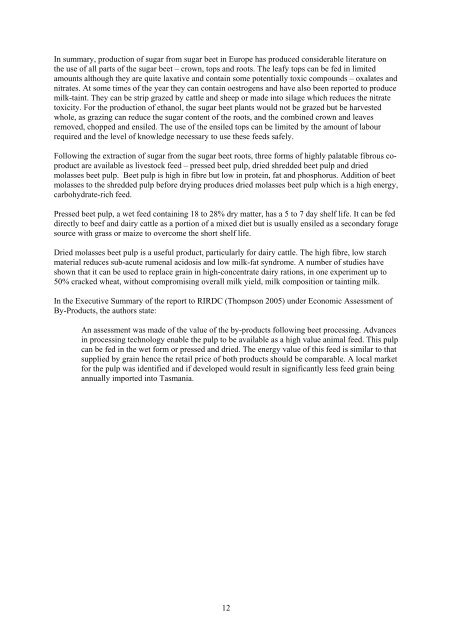Biofuel Co-Products as Livestock Feed
Biofuel Co-Products as Livestock Feed
Biofuel Co-Products as Livestock Feed
You also want an ePaper? Increase the reach of your titles
YUMPU automatically turns print PDFs into web optimized ePapers that Google loves.
In summary, production of sugar from sugar beet in Europe h<strong>as</strong> produced considerable literature on<br />
the use of all parts of the sugar beet – crown, tops and roots. The leafy tops can be fed in limited<br />
amounts although they are quite laxative and contain some potentially toxic compounds – oxalates and<br />
nitrates. At some times of the year they can contain oestrogens and have also been reported to produce<br />
milk-taint. They can be strip grazed by cattle and sheep or made into silage which reduces the nitrate<br />
toxicity. For the production of ethanol, the sugar beet plants would not be grazed but be harvested<br />
whole, <strong>as</strong> grazing can reduce the sugar content of the roots, and the combined crown and leaves<br />
removed, chopped and ensiled. The use of the ensiled tops can be limited by the amount of labour<br />
required and the level of knowledge necessary to use these feeds safely.<br />
Following the extraction of sugar from the sugar beet roots, three forms of highly palatable fibrous coproduct<br />
are available <strong>as</strong> livestock feed – pressed beet pulp, dried shredded beet pulp and dried<br />
mol<strong>as</strong>ses beet pulp. Beet pulp is high in fibre but low in protein, fat and phosphorus. Addition of beet<br />
mol<strong>as</strong>ses to the shredded pulp before drying produces dried mol<strong>as</strong>ses beet pulp which is a high energy,<br />
carbohydrate-rich feed.<br />
Pressed beet pulp, a wet feed containing 18 to 28% dry matter, h<strong>as</strong> a 5 to 7 day shelf life. It can be fed<br />
directly to beef and dairy cattle <strong>as</strong> a portion of a mixed diet but is usually ensiled <strong>as</strong> a secondary forage<br />
source with gr<strong>as</strong>s or maize to overcome the short shelf life.<br />
Dried mol<strong>as</strong>ses beet pulp is a useful product, particularly for dairy cattle. The high fibre, low starch<br />
material reduces sub-acute rumenal acidosis and low milk-fat syndrome. A number of studies have<br />
shown that it can be used to replace grain in high-concentrate dairy rations, in one experiment up to<br />
50% cracked wheat, without compromising overall milk yield, milk composition or tainting milk.<br />
In the Executive Summary of the report to RIRDC (Thompson 2005) under Economic Assessment of<br />
By-<strong>Products</strong>, the authors state:<br />
An <strong>as</strong>sessment w<strong>as</strong> made of the value of the by-products following beet processing. Advances<br />
in processing technology enable the pulp to be available <strong>as</strong> a high value animal feed. This pulp<br />
can be fed in the wet form or pressed and dried. The energy value of this feed is similar to that<br />
supplied by grain hence the retail price of both products should be comparable. A local market<br />
for the pulp w<strong>as</strong> identified and if developed would result in significantly less feed grain being<br />
annually imported into T<strong>as</strong>mania.<br />
12

















